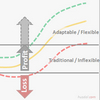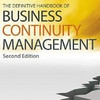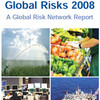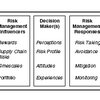 This paper was suggested by one of my readers, and upon reading it I must admit that it IS one of the better papers on supply chain risk management I have come across this year: An emergent framework for supply chain risk management and performance measurement by Bob Ritchie and Clare Brindley. Not only do the authors convey in a clear and precise manner what supply chain risk management is all about; they also construct a framework that provides a description of the factors that affect the nature of the risk management responses in particular situations.
This paper was suggested by one of my readers, and upon reading it I must admit that it IS one of the better papers on supply chain risk management I have come across this year: An emergent framework for supply chain risk management and performance measurement by Bob Ritchie and Clare Brindley. Not only do the authors convey in a clear and precise manner what supply chain risk management is all about; they also construct a framework that provides a description of the factors that affect the nature of the risk management responses in particular situations.
Supply Chain Risk Management Framework
Supply chain risk and supply chain risk management are not new problems, and have, along with risk and risk management, become dominant features in management. Managers are continuously being challenged, because
There are many unexpected and unpredictable disruptions that add to the risks of a supply chain.
and thus,
An important measure of management performance is the ability to successfully manage such risks.
and hence, Ritchie and Brindley make a very good attempt at providing a framework for supply chain risk management, and its components:
- Risk Context and Drivers
- Risk Management Influences
- Decision Makers
- Risk Management Responses
- Performance Outcomes
Much of the groundwork for this article has already been laid out in another article by Ritchie and Brindley, previously reviewed on this blog: Risk assessment and relationship management: practical approach to supply chain risk management.
Supply chains or networks?
Members of the supply chain are becoming increasingly inter-dependent, suggesting an inter-locking of interests. At the same time, each individual supply chain is unique in certain respects and this uniqueness may require unique approaches to the management of the risks involved. But what is a supply chain (or network?) really:
– they involve a chain of decision nodes, networked together;
– each node plays some role in adding value to the performance of every member of the chain, although this may be indirect and often minimal;
– each node has the potential to contribute to the risk profile of the decision to be taken, both positively and negatively; and correspondingly,
– each node exerts some influence on the successful, or otherwise, implementation of the management decisions and risk resolution.
This is an interesting perspective, because it clearly illustrates that decisions taken at the individual node has potentially chain-wide implications, more often than not these implications are unseen in the immediate vicinity of the node, but may resurface further up or down the supply chain. This is similar to risk factors, dynamics and impacts in A conceptual framework for analyzing risk in supply networks by Cheng and Kam (2008).
Supply Chain Risk Management
In defining supply chain risk and its components, six propositions are made:
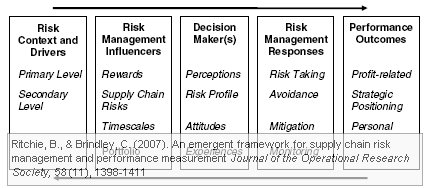
Supply Chain Risk Drivers
Aggregate Supply Chain Risk = f { (External Environment) * (Industry Specific Factors) * (Supply Chain Configuration) * (Partner Specific) * (Node Specific) }
Supply Chain Risk Management – Decision Makers
Aggregate Supply Chain Risk = f { (Individual) and/or (Groups) } * { (Perceptions) * (Attitudes) * (Experiences) * (Rewards) * (Penalties) }
Components of Business Performance
Aggregate Business Performance = f { (Profit) * (Risk) * (Time) }
Supply Chain Risks
Aggregate Risk = f { (Node Concentric Risk) * (Chain Diversified Risk) }
Supply Chain Risk and Risk Management
Aggregate Risk = f { [ (Node Concentric Risk) * (Risk Management Responses)] * [ ( Chain Diversified Risk) * (Risk Management Responses) ] }
Supply Chain Risk Management Portfolio
Aggregate Risk = Σ { f [ (Node Concentric Risk) * (Risk Management Activities)] * [ ( Chain Diversified Risk) * (Risk Management Activities) ] } + { f [ (Node Concentric Risk) * …
With this, the task of Supply Chain Risk Management is to balance the aggregate portfolio of risks within an acceptable level while seeking to ensure the generation of an acceptable level of reward or return on investment. The picture couldn’t be more complete than this.
Reference
Ritchie, B., & Brindley, C. (2007). An emergent framework for supply chain risk management and performance measurement Journal of the Operational Research Society, 58 (11), 1398-1411 DOI: 10.1057/palgrave.jors.2602412
Links
- linkedin.com: Professor Clare Brindley
- linkedin.com: Professor Bob Ritchie

